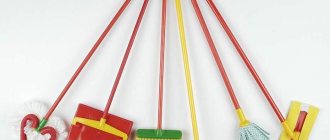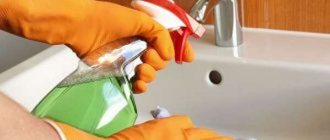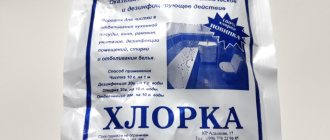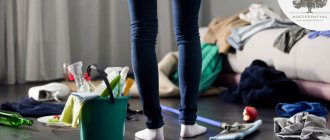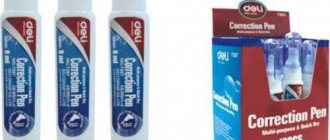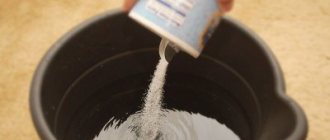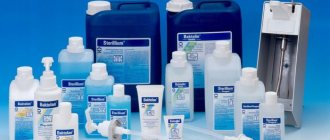The cleanliness of indoor floors must be maintained by regular cleaning, which includes mopping.
In order to not only clean the surface from dirt, but also disinfect it, household chemicals are used.
One of the popular and fairly cheap drugs is bleach. We'll tell you how to use bleach for cleaning floors in this article.
Can I wash with chlorine?
Bleach is used for disinfection and cleansing. To ensure the safe use of this substance, it is important to take precautions, as the drug is dangerous and toxic.
It should not come into direct contact with open areas of the skin, much less mucous membranes. Even inhaling chlorine solution fumes poses a danger.
To treat the floor, the substance is used in diluted form . Application is possible only with strict adherence to all safety rules.
This method of cleaning floor coverings is not suitable in all cases. Due to aggressive effects, discoloration and other damage to materials sensitive to caustic chemicals are possible. This cleaning method is best suited for processing tiles.
Chlorine solution is also used in medical institutions. The use of bleach to maintain surface hygiene is recommended by WHO during the coronavirus epidemic.
You can buy bleach in the household chemicals departments of hypermarkets and hardware stores. also be purchased in online stores and pharmacies .
In addition to the dry form of release, the modern product market offers many cleaning products containing chlorine, which are suitable for household use. They have a less pronounced specific odor, but remain highly effective.
These drugs include products from a number of brands:
- Chistin;
- Sanfor;
- Tiret;
- Ace;
- Domestos;
- Whiteness and other means.
In addition to bleach itself, chlorine-containing household chemical products can be used to wash and disinfect floors.
Areas of application of bleach
Chlorine-containing products are multifunctional . For many years they have been used for the following purposes:
disinfection of medical instruments, equipment, premises;- decontamination of biological media (feces, blood, vomit, urine) and food waste in hospitals;
- sanitation in preschool institutions, schools;
- sanitization of cages, vehicles, premises related to poultry and livestock farming;
- bleaching pulp and fabrics;
- wastewater treatment;
- chlorination of tap and well water, as well as swimming pools;
- production of household chemicals, pesticides, medications;
- other industries, including food.
Scope of application
The use of bleach in everyday life is associated with the need to solve the problem of cleaning and disinfecting surfaces.
One of the advantages of using such a composition is its high efficiency and rapid achievement of results. The product can eliminate pathogenic microorganisms in a short time, on average from 10 minutes to an hour.
The areas of application of bleach and chlorine-containing preparations include the following:
- mold removal;
- elimination of animal odor;
- stain removal;
- disinfection.
The drug is used for:
- treating greenhouses against fungus,
- disinfection of swimming pools,
- disinfection of animal cages, carriers and trays,
- for disinfection of public toilets, etc.
Why is chlorine added to detergents?
We have all been familiar with the smell of chlorine since childhood, when schools, hospitals, swimming pools and other institutions used cheap liquid with a chemical concentrate during cleaning. Many people still associate this persistent and pungent smell with cleanliness and disinfection.
Today, chlorine is still an essential ingredient in inexpensive cleaning products. It is found in bleach, toilet cleaners, sink and bathtub cleaning gels, multi-surface cleaners, mildew-killing liquids, and even dishwasher cleaning tablets. Manufacturers thus achieve the desired effect of cleaning, whitening and disinfection. After all, these are long-known and confirmed properties of chlorine.
It can be “hidden” in household chemicals under different names: hypochlorite, sodium hypochlorite, sodium dichloroisocyanurate, methylchloroisothiazoline or hydrogen chloride. But this does not change its physical and chemical properties in any way.
META-ANALYSIS
The Invisible Threat: Toxic Substances in Your Home
ESI has initiated research and evidence gathering into what is really happening in the cleaning products industry to educate people, warn them and help protect their health.
Download, read, be healthy and enjoy life...
Instructions for use
The use of bleach for disinfection can have different effects. It depends on the concentration of the composition and the duration of exposure to the surface to be treated.
Breeding
Pure bleach is not used to treat flooring. A ready-to-use solution is obtained by dilution .
The percentage of concentration of the solution is determined by the scope of application. For example, a 5% solution is used to disinfect instruments in sanitary facilities, and 0.25% is suitable for hand disinfection. For treating floors in apartments, a 0.5% solution can be selected.
Preparation of a solution from a tablet (compressed) form:
Pour 10 liters of water into a large bucket.- Add 3 or 4 tablets of bleach.
- Stir.
- Leave to dissolve completely.
If the product is available in powder form , then the solution should be prepared as follows:
- 30 grams of bleach are diluted in 1 liter of water;
- stand for several minutes for better dissolution.
The resulting solution should not be shaken. Do not use metal containers for storage containers, since the chlorine solution reacts.
Cleaning algorithm
The floor cleaning procedure should include the following steps:
- Clear the floor of unnecessary objects that may interfere with the treatment.
- Remove pets and children from the premises.
- Use personal protective equipment - a respirator and rubber gloves.
- Prepare the solution.
- Prepare rags for cleaning.
- Organize good ventilation in the room.
- Remove trash from the floor.
- Wash floors, paying attention to corners and hard-to-reach areas.
- Open the windows to ventilate the room.
Before starting floor treatment, you should check the reaction of the floor covering to contact with the solution. To do this, you need to apply the already prepared product to an inconspicuous area and leave for a quarter of an hour.
After this time, assess the condition of the coating. If there is no negative effect, continue treating the entire floor with bleach.
What to do with the smell of the drug if it does not disappear?
How long the smell will persist in a room that has been wet cleaned with chlorine depends on the following factors:
- Solution concentration.
- Surface area.
- Type of surface (ability of the coating to absorb odors).
- Quality of ventilation organization.
In order not to cause harm to health, the use of chlorine must be carried out in accordance with a number of rules:
- the concentration should not be exceeded when preparing the solution;
- cleaning must be carried out with good ventilation;
- after cleaning, organize ventilation.
Such “odor absorbers” as:
- Activated carbon;
- raw rice;
- baking soda;
- salt.
The listed substances can be poured into open containers and placed indoors. You can use one of the listed products, or several at once.
If after cleaning and airing the smell is still felt, the floors can be washed by adding a few drops of citrus or pine essential oil to the water.
Where to buy disinfectants
Disinfectants with chlorine are quite cheap and in demand. Therefore, problems with their acquisition never arise. You can buy bleach or its derivatives at pharmacies, hardware stores, or the household goods section of the supermarket. The widest selection of such products is presented on the pages of online stores. Possible options for disinfectants with active chlorine for purchase wholesale and retail:
- Bleach - bags (20 kg) or steel drums.
- Sodium hypochlorite - 20 l canisters.
- Chloramine - packages from 250 g.
- Products in tablets and granules - pack of 300 tablets. or 1 kg.
- Detergents, cleaners and bleaches with chlorine - packaging from 1 liter (1 kg).
The content of active chlorine in them may vary. Therefore, when preparing solutions, you must strictly follow the instructions included with the product. Each buyer makes his own decision about which product option is better. It depends on the goals pursued and personal preferences. All chlorine-containing products, when used correctly and in compliance with the recommended concentrations, are quite effective.
Precautionary measures
Bleach in any form is a dangerous substance that should be used very carefully, ensuring that all rules are followed at every stage.
Frequent washing
The frequency of disinfection work using bleach depends on the purpose of the room in which the cleaning is carried out. In public premises, the frequency of floor washing is in the corridors 2 times a day , in the doctor's office - once a day.
In most cases, washing the floor with a disinfectant in a residential area too often is not justified, since this increases the amount of evaporation and increases the concentration of chlorine in the air. The best option is once a week. An exception is the room in which there is an infectious patient.
Possibility of poisoning
If you violate the rules for using bleach, there is a risk of poisoning with the drug. The danger comes from contact of the substance with exposed areas of the body, eyes and mucous membranes. Even vapors of chlorine-containing compounds can lead to poisoning if inhaled.
This may appear:
- shortness of breath;
- redness of the eyes;
- burning and discomfort in the eyes;
- cough;
- difficulty breathing;
- sore throat.
Accidental ingestion of even a small amount of the drug can lead to a burn to the digestive organs and oral cavity. In all these cases, it is necessary to consult a doctor.
Chlorine is a poisonous gas that was used during World War I as a chemical weapon.
Storage conditions
Bleach is available in various forms - solutions, tablets and powder. Storage rules are always indicated by the manufacturer on the packaging. Such a product must be kept in a closed container, away from heating devices, and out of the reach of children. The expiration date of the product is indicated on the packaging.
Recommendations and rules of use
Rules for using bleach in everyday life include the following:
- Do not use chlorine and other cleaning agents in the same solution, as their combination may cause an unexpected reaction.
- All work with hazardous substances must be carried out with good ventilation.
- The use of personal protective equipment is mandatory.
- During storage, chlorine should not be adjacent to food products, clothing, or hygiene products.
- The container with chlorine must be securely closed to eliminate the possibility of evaporation of the product and the entry of foreign substances into the container.
Bleach should not be used by children under 18 years of age, people with allergies, or pregnant or lactating women.
Yellow-green gas
This is exactly the color that chlorine has under normal conditions. It is a heavy gas with a pungent odor and unpleasant taste.
Chlorine is very common in nature - it is active and easily combines with a wide variety of substances. For example, ordinary table salt is nothing more than sodium chloride, that is, a compound of sodium and chlorine. This substance is necessary for all of nature and the human body - just in a certain form and in small quantities.
It is widely used in a wide variety of industries. We are more interested in its use in everyday life. Chlorine is part of bleach and disinfectants. Two of its properties stand out here: The ability to bleach almost any dye. But he does this in a solution with water. Technically, it is not chlorine itself that bleaches, but oxygen, which is formed when the mixture of chlorine and water breaks down. Ability to kill microorganisms and insects.
